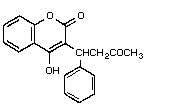Warfarin: An anticoagulant that is highly effective in controlling Norway (Brown) rats and house mice. It is a chronic rodenticide, odorless, tasteless and effective in very low dosages. Action is not rapid, usually about a week is required before a marked reduction in the rodent population is effected. Warfarin has found very ready acceptance because rodents do not tend to become bait shy after once testing the material. They continue to consume it until its anticlotting properties have produced death through internal haemorrhaging. Though rodents became resistant to warfarin in the late 70's early 80's, it can now be used again. Warfarin comes in water soluble, ready-to-use bait, concentrate, powder, liquid concentrate, nylon pouch, coated talc and dust formulations. The compound also comes in mixed formulations with pindone, calciferol, and sulphaquinoxaline. It is considered compatible with other rodenticidesChemical Name: 3(a-acetonylbenzyl)-4-hydroxycoumarin or (RS)-4-hydroxy-3-(3-oxo-1-phenylbutyl)coumarin.
Chemical Formula:C19H16O4
Chemical Structure:
LD50/LC50: The amount of Warfarin that is lethal to one-half (50%) of experimental animals fed the material is referred to as its acute oral lethal dose fifty, or LD50. The acute oral toxicity for warfarin in rats is variously reported to be 3 mg/kg, 1,600 ug/kg, 186 mg/kg (Hartley and Kidd, 1987); 58 mg/kg in female rats. The acute oral LD50 for rats over 4-5 days is 1 mg/kg/day. There was no development of ingestion tolerance indicated regardless of rodent sex or age.
The acute oral LD50 for technical sodium warfarin in rats was 323 mg/kg for males and 58 mg/kg for females. A single, large dose of warfarin is about as toxic as a single, small dose. On a multiple-dose basis, the reported LD100 for rats is 0.2 mg/kg/day for 5 days.
The dermal LD50 for rats was 1,400 mg/kg; 420 mg/kg intraperitoneal LDlo (Lethal Dose, Low. The lowest dose which causes death in test animals.); and 320 mg/m3 inhalation LC50. The same source indicated the acute oral LD50 for mice was 60 mg/kg; 800 mg/kg subcutaneous LDlo; and 165 mg/kg intravenous LD50.
Toxicity values for warfarin in other animals are: an oral LD50 for cats of 2.5-20 mg/kg; an acute oral LD50 of 35 mg/kg for a single dose or 3 mg/day for 5 days; and 12 mg/kg oral LDlo. The acute oral LD50 for dogs exposed to warfarin was 3 mg/kg/day for 5 days. Technical sodium warfarin in dogs had an LD50 of 200-300 mg/kg. The acute oral LD50 for warfarin in cattle was 200 mg/kg/day for 5 days. The LD50 for technical sodium warfarin in guinea pigs was 182 mg/kg. The oral LDlo for warfarin in pigs was reported to be 1,200 ug/kg. Death followed 5 daily doses of 1 mg/kg for pigs.
Studies done on rabbits indicated the dermal LD50 of warfarin to be greater than 8 g/kg. Technical sodium warfarin in rabbits had an LD50 of 800 mg/kg. Rabbits exhibited mild to slight conjunctival irritation in response to technical warfarin.
Toxicity values for humans exposed to warfarin indicated an oral-woman TDlo of 15 mg/kg/21 weeks intermittent; 10,200 ug/kg oral-man TDlo; and 6,667 mg/kg oral-human LDlo. Average or large doses of warfarin in humans may cause hemorrhage. Warfarin is not known to be an eye irritant. It has produced hemorrhages in the retina, however, through its systemic toxicity. The compound is considered highly toxic by inhalation and ingestion and moderately toxic by dermal absorption. A dose of warfarin at 200 mg/m3 is considered highly toxic and immediately dangerous to life or health.
Warfarin has been established as a human teratogen, because it causes birth defects in the offspring of women receiving clinical doses of the compound during any trimester of pregnancy. Therapeutic use by pregnant women has resulted in fatal hemorrhaging of the fetus and malformations and mental retardation in infants. However, the amount of warfarin contained in the rodenticide bait is very low. A single ingestion of warfarin-treated bait by an adult female would not be likely to cause teratogenic effects.
Effects on Birds:
The acute avian toxicity of warfarin indicates that it is practically non-toxic to game birds. In subacute studies, warfarin ranged from moderately toxic to practically non-toxic to upland game birds and waterfowl. Another source indicated that an acute oral mallard duck study was performed with a 10% formulation of warfarin. This formulation of warfarin was considered moderately toxic to mallard ducks (LC50 greater than 120 mg/kg) when administered as a single dose. However, when exposed to 60 mg/kg for a period of 14 days, 4 out of 5 ducks died.
Effects on Aquatic Organisms:
The toxicity of warfarin to aquatic organisms is felt to be of low potential due to the fact that warfarin is insoluble in water. A long field experience shows no potential hazards to aquatic organisms.A 96-hour rainbow trout study was performed using a 0.54% formulation of warfarin sodium salt. With a 96-hour LC50 of greater than 10,000 ppm, this formulation is considered non-toxic to rainbow trout.
Effects on Other Animals (Nontarget species):
Warfarin used as a prepared bait (0.13%) is considered non-toxic to bees when used as prescribed.The use of warfarin as a hand-placed bait limits the potential for any secondary exposure of nontarget animals. However, because of its high degree of mammalian toxicity and its use patterns, warfarin could adversely affect endangered or threatened species. One study exists on a 50/50 percent formulation of warfarin-sulfaquinoxaline technical. The warfarin- sulfaquinoxaline caused secondary poisoning in mammalian carnivores such as mink and dogs when ingesting prey killed after they were provided with treated bait (carrots containing 0.025% by weight of the test material). The first death occurred after 8 days of continuous exposure to treated nutria.
